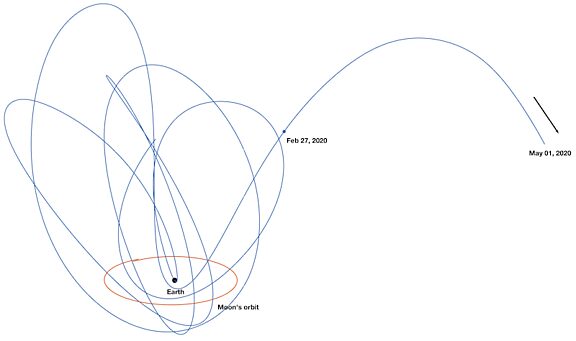Earth’s quasi-moons, minimoons, and ghost moons

Written by
Asa Stahl, PhD
Science Editor, The Planetary Society
May 21, 2024
Earth hosts seven known quasi-moons, an unknown number of minimoons, and maybe, sometimes, two ghost moons. Though none of these pseudo-moons are as big or influential as Earth’s one true natural satellite — the Moon — they are still valuable for science and exploration. Quasi- and minimoons offer promising targets for future space missions, a window into our planet’s neighborhood, and a sampling of the sort of asteroids that could potentially hit Earth.
Quasi-moons
Earth’s quasi-moons get their name because, from a certain vantage point, they appear to act like moons. But from a wider perspective, it becomes obvious that they aren’t really moons at all — they’re asteroids.
It’s like a gravitational sleight of hand. From a point of view that rotates with Earth around the Sun, each of these asteroids looks like it is orbiting our planet, yet they actually orbit the Sun. In fact, Earth's quasi-moons essentially share our planet's orbit. They follow almost the exact same path as we do around the Sun.

But as these asteroids trace their orbits, they are also slightly affected by Earth’s gravity. They don’t circle Earth, like satellites. Instead, their orbits fall into a kind of lockstep with our planet that keeps them close by. A quasi-moon sometimes drifts ahead of Earth and sometimes trails behind it as both go around the Sun. From a certain vantage point, this makes it look like the quasi-moon is orbiting us instead of our star.
Such a configuration is called quasi-satellite motion, and it is one of several ways that celestial bodies can share an orbit with Earth. There are also “trojan” orbits, where an object traces loops around a point that stays consistently ahead of or behind Earth as it goes around the Sun. And there are “horseshoe” orbits, where an object switches between leading and trailing Earth in its orbit, but without staying close to Earth like in quasi-satellite motion.
Our newest quasi-moon
On August 29, 2025, astronomers discovered the latest addition to Earth's known quasi-moons. Called 2025 PN7, the asteroid is about 20 meters (66 feet) wide. Scientists estimate that it has been a quasi-moon for about 60 years already and will remain so for another 60 years. The find came out of the Pan-STARRs observatory, in Hawaii.
All of Earth’s known quasi-moons are temporary. After hundreds or thousands of years, most will transition to trojan or horseshoe orbits. At the same time, some asteroids that are currently in one of those other kinds of shared orbits will eventually transition and become quasi-moons.
Minimoons
A minimoon, on the other hand, is an object that truly but temporarily orbits a world. Earth’s minimoons last for less than a year on average. They are very small and hard to detect: only four minimoons of Earth have ever been discovered, and none are still orbiting our planet today. Some may actually have been space debris. The Gaia spacecraft was once mistaken for a minimoon, and so were rocket stages from the Chang’e 2 and Lunar Prospector missions.

Ghost moons
Ghost moons — if they really exist — are swirling clouds of dust that share Earth’s orbit, staying ahead of or behind Earth as it goes around the Sun. Officially called “Kordylewski clouds,” ghost moons were first reported in the 1960s and were only tentatively confirmed in 2018. There is still no broad consensus on whether these clouds exist. It’s possible they appear and disappear depending on the influence of the Sun and planets.
What other worlds have quasi-moons?
Quasi-moons can orbit other planets, moons, or even asteroids. Venus, Jupiter, Saturn, Neptune, Pluto, and the asteroid Ceres all host at least one known quasi-moon. The first quasi-moon ever discovered, Zoozve, goes around Venus. It gained its unusual name in a quirk of history, when an artist misread its original identifier 2002 VE68.
Could quasi-moons or minimoons hit Earth?
Scientists used to think certain quasi-moons had a significant chance of impacting Earth, but thankfully, that’s no longer the case. Since Earth’s current quasi-moons are around 10–300 meters (30–1000 feet) in size, some are large enough to cause massive damage to a region if they were to hit us. But there is no risk of a known quasi-moon colliding with Earth in the foreseeable future. The orbits of quasi-moons are predictable enough that astronomers should be able to see an impact coming well before it happens.
As for minimoons, it’s not rare for them to hit Earth. About 1% of all minimoons eventually do, but most are small, so they burn up in our planet’s atmosphere. A very dangerously large minimoon, say 1 kilometer (0.6 mi) in diameter, is expected to hit Earth once every billion years at most.
What can these not-quite-moons tell us?
Quasi-moons and minimoons are pieces of our neighborhood in space, and they carry information about where they come from. These rocks might originate in the main asteroid belt, from impacts on the Moon, or from the break-up of larger objects on similar orbits — scientists don’t know for sure. Answering that question, and finding out what these almost-moons are made of, can help researchers learn more about asteroids and how they threaten Earth.
Since quasi-moons orbit close to Earth and are often quite small, they would also be easier to visit and redirect than most other asteroids. This makes them ideal targets for missions like China’s Tianwen-2. Launched in 2025, Tianwen-2 will visit the quasi-moon 469219 Kamoʻoalewa, collect samples, and explode part of the asteroid’s surface to see what lies beneath. In the future, quasi-moons around other worlds could even act as science platforms, offering a vantage point for monitoring whatever body they loop around.

Support our core enterprises
Your gift today will go far to help us close out the year strong and keep up our momentum in 2026.
Donate

 Explore Worlds
Explore Worlds Find Life
Find Life Defend Earth
Defend Earth

